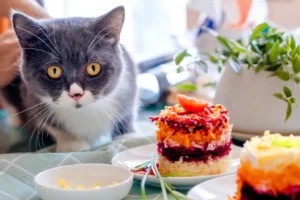Cats are known for their peculiar behaviors, and one of those behaviors includes being attracted to cat litter. But why exactly are cats drawn to cat litter? Let’s delve into this fascinating topic.
The Appeal of Cat Litter
Cat litter is like a magnet for our feline friends, and it’s not just because they enjoy digging around in it. One of the main reasons cats are attracted to cat litter is its texture. Cats have sensitive paws, and the soft, sandy feel of litter resembles the natural substrate they would typically use to bury their waste in the wild. This familiarity makes it comfortable and appealing for them to use.
Additionally, cat litter’s ability to absorb moisture and odors is another factor that draws cats in. Cats are naturally clean animals, and they prefer to eliminate in a place that doesn’t retain smells or feel damp under their paws. The absorbent nature of cat litter helps maintain cleanliness, which is essential for cats when selecting a bathroom spot.
Moreover, some cat litters are scented to mask odors or mimic natural scents that cats are attracted to. This can further entice them to use the litter box regularly. Overall, the combination of texture, absorbency, and scent all work together to make cat litter an attractive option for our feline companions.
Scent Sensitivity
Cats have a superpower when it comes to their sense of smell. Their noses contain around 200 million scent receptors, compared to a human’s 5 million, giving them a hypersensitive olfactory system. This heightened sense of smell plays a significant role in their attraction to cat litter.
From a cat’s perspective, the scent of their litter box serves as a vital communication tool. Cats mark their territory with their scent, and familiar scents in the litter box signal that it’s a safe and appropriate place to relieve themselves. This instinctual behavior dates back to their wild ancestors, where scent marking played a crucial role in survival.
The scents added to cat litter can also trigger positive associations for cats. Some litters contain natural scents like lavender or cedar, which are calming and pleasing to cats. These scents can help create a more inviting bathroom environment for cats, encouraging them to use the litter box regularly.
In conclusion, a cat’s keen sense of smell not only guides their behavior but also influences their preferences for the type of litter they use. By understanding and catering to their scent sensitivity, we can provide a comfortable and appealing bathroom experience for our feline friends.
Instinctual Behavior
Cats have a natural instinct to bury their waste to avoid detection by predators. In the wild, this behavior helps them stay hidden from potential threats. This instinctual need to bury their waste is why cats are attracted to cat litter. Providing a suitable substrate for elimination satisfies this instinct and makes them feel secure in their environment.
Texture Preference
The texture of cat litter plays a significant role in why cats are drawn to it. Cats have sensitive paw pads, and they prefer a substrate that feels comfortable to them. Cat litter provides a soft, granular texture that mimics the feel of natural soil or sand. This texture is appealing to cats and encourages them to use the litter box consistently.
Additional Insight:
– Cats also appreciate the texture of cat litter because it allows them to easily cover their waste. In the wild, covering their scent helps prevent predators from tracking them. Cat litter provides a similar experience for indoor cats, giving them a sense of security and privacy while using the litter box.
Marking Territory
Cats are notorious for their territorial behavior, and they use their litter box as a way to mark their territory. By urinating and defecating in their litter box, cats leave behind their scent, which serves as a familiar and comforting marker of their space. This behavior is deeply rooted in their instincts as independent and territorial creatures. Therefore, the presence of cat litter, which absorbs and retains their scent, is essential for cats to feel secure in their environment.
Additionally, cats have scent glands in their paw pads, and by digging in the litter, they release these pheromones, further marking their territory. This pawing behavior also helps them feel like they are covering their waste, much like they would in the wild to avoid attracting predators.
Clumping vs. Non-Clumping
When it comes to cat litter, there are two main types: clumping and non-clumping. Clumping litter forms solid clumps when in contact with moisture, making it easier to scoop out the waste and maintain a cleaner litter box. Cats are generally attracted to clumping litter because of its ability to trap odors effectively and provide a cleaner environment for them to do their business.
On the other hand, non-clumping litter does not form tight clumps when wet and requires more frequent changing. Some cats may be less attracted to non-clumping litter due to the lack of odor control and the messier nature of the litter box. It’s essential to consider your cat’s preferences and habits when choosing the type of litter to ensure they are comfortable and consistently using their litter box.
Clumping Litter:
- Excellent Odor Control: Helps minimize odors, keeping your home smelling fresh.
- Easy to Clean: Forms tight clumps for easy scooping, reducing maintenance time.
- Preferred by Many Cats: The texture and odor control of clumping litter make it a popular choice.
Remember, cats have individual preferences, so it may be necessary to experiment with different types of litter to find what works best for your cat’s needs and preferences.
Alternatives to Cat Litter
Alright, so you’ve got a finicky feline who’s not digging the traditional cat litter. No worries, there are some alternatives you can try out. One option is paper pellets made from recycled paper. These pellets are super absorbent and are a great eco-friendly choice. Another alternative is crystal cat litter, which is excellent at locking in odors.
Now, when it comes to attracting your cat to these alternatives, it might take some time for them to adjust. Start by mixing a small amount of the new litter with their old one and gradually increase the ratio. Remember, patience is key when introducing something new to your furry friend.
Extra tip: Some cats have preferences for specific textures or scents, so don’t be afraid to try out a few different alternatives to see which one your cat likes best.
Encouraging Litter Box Use
Alright, so your cat might be turning their nose up at their litter box. But fear not, there are ways to make their bathroom experience more pleasant. First off, make sure the litter box is clean and scooped regularly. Cats are clean creatures and prefer a tidy bathroom situation.
Another tip is to have multiple litter boxes in different locations around your home. Cats like options, just like us! And make sure the litter box is in a quiet, private spot so your cat can do their business in peace.
Extra tip: Some cats are sensitive to scented litters, so opt for unscented varieties to avoid any aversion to their bathroom spot. Always put your cat’s preferences first!
Fun Facts About Cat Litter
Did you know that cats are naturally attracted to cat litter because of their instinct to bury their waste? This behavior is rooted in their survival instincts as wild cats would bury their waste to hide their presence from predators. So, when your cat uses the litter box, it’s simply following its natural instincts!
Another interesting fact is that the first commercially available cat litter was developed in 1947 by a man named Ed Lowe. He came up with the idea after a neighbor asked him for some sand to use as cat litter, sparking the creation of the cat litter industry as we know it today.
Furthermore, cats are drawn to cat litter that mimics the texture of sand or soil, providing a familiar and comfortable surface for them to do their business. This is why clumping clay litters are often preferred by cats, as they closely resemble the feel of natural substrates like sand.
Eco-Friendly Options
When it comes to choosing a cat litter that is better for the environment and appealing to your feline friend, eco-friendly options are the way to go. One popular eco-friendly choice is biodegradable litter made from materials like recycled paper, pine, corn, or wheat. These litters are not only sustainable but also softer on your cat’s paws.
Another eco-friendly option to consider is silica gel litter, which is made from silica dioxide sand and is highly absorbent, reducing the frequency of litter changes. This type of litter is odor-free, making it a great choice for both you and your cat.
If you’re looking to minimize your environmental impact while keeping your cat happy, consider giving these eco-friendly cat litter options a try. Your cat will thank you, and the planet will too!
Additional Unique Insight: A lesser-known eco-friendly option is tofu cat litter, which is made from compressed soybean residue. Not only is it environmentally friendly, but it’s also flushable and biodegradable, making cleanup a breeze and reducing waste.
Remember: Always transition your cat gradually to a new litter to avoid any aversion or confusion.
Alex, a passionate animal lover, has experience in training and understanding animal behavior. As a proud pet parent to two dogs and three cats, he founded AnimalReport.net to share insights from animal experts and expand his knowledge of the animal kingdom.




